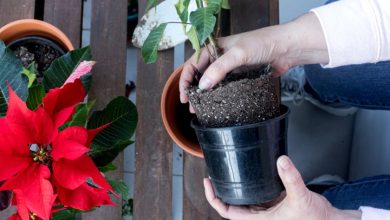Plant Snapdragon in your Garden: [Guide + Steps to Follow]

Antirrhinum majus or dragon antirrhinum, also known as snapdragon, is a perennial plant native to the Mediterranean. It is also called dragonaria or lion’s mouth.
It is a very aromatic plant that can reach, depending on the variety, up to two meters in height. Medicinal properties have also been found.
Important points for Sowing Snapdragon:
- When? in early spring.

- Where? In temperatures between 18 and 20 ºC.
- How do we prepare the land? The optimal pH ranges between 6.2 and 7.0. They prefer calcareous and dry soils, well drained and fertilized.
- How do we water? Watering the soil avoiding touching the plants and flowers. Avoid making puddles.
- How often do we water? When it’s hot, daily. When it’s cold, once or twice a week.
- How do we sow? Placing the shoots 30 cm between each other.
- Diseases and pests? Mildu, red spiders, nematodes and powdery mildew.
Common in many gardens of various kinds; This is because it is a plant that when it reaches maturity is tremendously beautiful.
They have a stem of between 50 and 80 cm, with a woody base, with clusters of flowers that cascade. They show a large corolla and can befind in virtually every color, being the most common the violets, the red ones, the white ones, the orange ones and the yellow ones.
They are normally grown as annuals, but can be raised as biennials as long as they are protected from the cold.
To learn more about how to plant flowers:
- Plant orchids.
- Plant saffron.
- Plant tulips.
- Plant carnations.
- Plant vanilla.
- Plant wild flowers.
- Plant pretty flowers.
- Plant water lilies.
What do we need to plant snapdragon?
When should it be sown? The dates
The snapdragon must be planted in a pot, preferablyearly spring, since they are plants that are not very tolerant to frost.
They can also be sown outdoors in the fall.
They usually bloom in the period between spring and autumn.
Where? The temperature and the light
They can be planted in an area of full sun or partial shade. Ideally, they should receive at least6 hours of direct sunlight.
The optimum temperature is between 18 and 20 ºC.
How often and how should it be watered?
 In times ofhigher heat, watering should be daily, but moderate. In wetter and cooler times, it can be watered up to once or twice a week.
In times ofhigher heat, watering should be daily, but moderate. In wetter and cooler times, it can be watered up to once or twice a week.
They are very prone to fungus, so moderate watering is necessary, avoiding waterlogging. A drip irrigation system is recommended.
In any case, the snapdragon plant is considered to be quite hardy compared to other flowers.
How do we prepare the land?
They prefer calcareous and dry soils, well drained and fertilized; preferably exposed to full sun.
The optimal pH should range between 6.2 and 7.0.
You can improve the substrate by adding organic matter such as leaf-based compost, so that your snapdragons produce long- lasting flowers.
How to plant snapdragon step by step
1. Prepare the pot
 Get a pot that is at least 6 inches deep and fill it with seed substrate, making sure it has good drainage.
Get a pot that is at least 6 inches deep and fill it with seed substrate, making sure it has good drainage.
It is not necessary to use fertilizer, although if you think it is necessary, you can use mulch to give the seeds more nutrients.
placethe seed to a depth of 2 to 5 centimeters. Then, cover it with soil and place the pot in a warm but well-lit place.
Make sure to keep the substrate evenly moist.
2. Promotes the appearance of flowers and prepares the transplant
Pluck the top end of each stem when the shoots have produced six or more leaves. This will favor the appearance of flowers.
Once the shoots have started to grow you will need to transplant them.
3. Clear the ground
 Remove weeds and remains of previous crops and all kinds of residues to ensure that your snapdragons receive the proper amount of nutrients.
Remove weeds and remains of previous crops and all kinds of residues to ensure that your snapdragons receive the proper amount of nutrients.
All plants must be pulled out by the roots to prevent them from growing back.
4. Prepare the ground
Moisten the soil before transplanting. This will prevent the plant from shifting easily
Fertilize the soil. Plow the soil well and spread a layer of compost about 10 cm. Compost will help conserve moisture and regulate temperature.
If you prefer, you can also apply a good composition of peat and earthworm humus.
5. Put the seedlings in the soil
Place your shoots at a distance of 30 cm between each other. This distance will keep the plants ventilated and prevent the appearance of fungi and other diseases.
6. Water the newly transplanted shoots
 Water them to keep the soil well hydrated. After this initial watering, you should maintain a regular watering schedule as the tree grows.
Water them to keep the soil well hydrated. After this initial watering, you should maintain a regular watering schedule as the tree grows.
Preferably, water the soil avoiding touching the plants and flowers.
7. Fertilize the soil
You should fertilize the land every two weeks starting in the spring and throughout the summer, diluting the liquid fertilizer in the irrigation water. Outside this period, no payment is due.
8. Remove faded flowers
In reality, the snapdragon does not require pruning. However, from time to timewithered flowers should be removedto avoid transmitting parasitic diseases.
9. Keep warm
Use organic mulch to cover the area around the snapdragons’ roots.
In this way, you will keep the root systems cool when temperatures rise, increasing the life of your plants before they start to wilt in the summer heat.
Snapdragon pests and diseases
Some of the most common pests and diseases that affect snapdragons are:
Red spider
 To combat the red spider, it is recommended to water at night by sprinkling to maintain humidity and use natural insecticides.
To combat the red spider, it is recommended to water at night by sprinkling to maintain humidity and use natural insecticides.
Neem extract is also often effective.
nematodes
To control them, we can plant garlic cloves as a repellent. They can also be treated with steam sterilization and solarization.
mildew
To combat it, it is recommended to eliminate weeds and crop debris. Likewise, excess humidity should be avoided, ventilating the crop.
powdery mildew
It is best to install a drip irrigation system and apply horsetail as prevention.
It also works to eliminate weeds and crop debris, as well as promote ventilation of the crop.



![Photo of Acerola: [Cultivation, Irrigation, Care, Pests and Diseases]](https://www.complete-gardening.com/wp-content/uploads/2022/08/acerola-cultivation-irrigation-care-pests-and-diseases-390x220.jpg)
